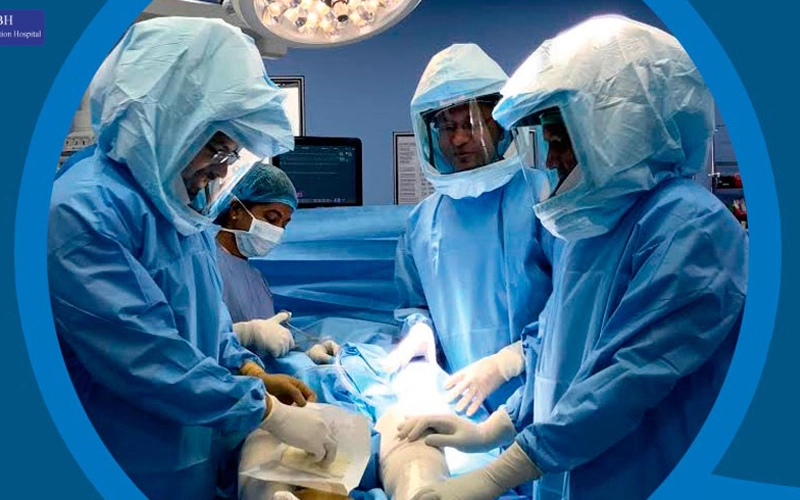Orthopedic emergencies encompass a wide range of injuries and conditions affecting bones, joints, and muscles, which can occur unexpectedly and require immediate medical attention. While some orthopedic issues develop gradually, emergencies demand swift action to prevent long-term damage, complications, or even life-threatening consequences.

Dr. Gautam Gupta, a highly experienced orthopedic specialist, has treated numerous emergency cases throughout his career. In this comprehensive guide, Dr. Gupta sheds light on common orthopedic emergencies, the steps to take when faced with one, and when to seek immediate help.
1. Fractures: Identifying and Managing Broken Bones
Fractures, or broken bones, are one of the most common orthopedic emergencies. They can occur due to accidents, sports injuries, or falls and vary in severity. While some fractures may be minor and stable, others can be life-threatening, especially if they involve larger bones like the femur (thigh bone) or are compound fractures where the bone pierces the skin.

Recognizing a Fracture
Dr. Gupta advises that fractures can usually be identified by:
- Intense pain at the site of injury
- Inability to move the affected limb
- Swelling or bruising
- Visible deformity in more severe cases
Immediate Steps
If you suspect a fracture:
- Immobilize the injured area using a splint or makeshift support.
- Avoid moving the injured limb unless necessary.
- Apply ice packs to reduce swelling but avoid placing ice directly on the skin.
- Seek emergency medical help, especially for compound fractures, head injuries, or fractures involving major bones.

2. Dislocations: When Joints Slip Out of Place
Joint dislocations occur when the ends of two connected bones are forced out of their normal position. This is common in joints like the shoulder, knee, elbow, and fingers, often caused by high-impact trauma or accidents.
Recognizing a Dislocation
Dr. Gupta points out the following symptoms of a dislocated joint:
- Intense pain, especially when attempting to move the joint
- Visible deformity or out-of-place appearance
- Swelling and bruising
- Loss of movement or instability

Immediate Steps
For a dislocated joint:
- Do not attempt to force the joint back into place.
- Immobilize the joint in the position it is found.
- Apply ice to reduce swelling.
- Seek emergency medical attention as quickly as possible to avoid long-term damage to surrounding tissues, ligaments, or nerves.
3. Ligament Tears: Common in Sports Injuries
Ligament tears, particularly involving the knee or ankle, are a frequent orthopedic emergency, often sustained during sports or high-impact activities. The anterior cruciate ligament (ACL) in the knee is one of the most commonly torn ligaments.

Recognizing a Ligament Tear
Dr. Gupta notes the following signs:
- Sudden “popping” sound or sensation at the time of injury
- Immediate swelling and pain
- Inability to bear weight on the affected joint
- Instability or “giving way” of the joint
Immediate Steps
For a suspected ligament tear:
- Rest the injured joint and avoid bearing weight.
- Apply ice to minimize swelling.
- Elevate the injured limb.
- Seek medical attention to assess the severity of the tear and receive proper treatment, which may include physiotherapy, bracing, or even surgery.
4. Severe Back or Neck Injuries: Risks of Spinal Trauma
Spinal injuries, including those to the back and neck, are among the most serious orthopedic emergencies. These injuries can result from falls, car accidents, or sports trauma and have the potential to cause paralysis or permanent disability if not treated immediately.

Recognizing a Spinal Injury
Signs include:
- Intense pain in the back or neck
- Numbness, tingling, or loss of sensation in the limbs
- Inability to move parts of the body
- Muscle weakness
- Difficulty breathing (in severe cases involving the cervical spine)
Immediate Steps
For suspected spinal injuries:
- Do not move the injured person unless they are in immediate danger.
- Keep the person as still as possible and immobilize their head and neck.
- Call emergency services immediately.
- Avoid trying to reposition the person, as this can exacerbate spinal injuries.

5. Severe Muscle or Tendon Tears: When Surgery May Be Required
While muscle and tendon tears can sometimes heal with rest and conservative treatment, severe cases may require emergency intervention, especially if the injury involves major tendons like the Achilles tendon or rotator cuff.
Recognizing a Muscle or Tendon Tear
Symptoms of a severe tear include:
- Sudden, sharp pain at the site of injury
- Inability to move the affected muscle or joint
- A “gap” or visible deformity where the muscle or tendon has torn
- Significant swelling and bruising
Immediate Steps
For a suspected muscle or tendon tear:
- Rest the injured area immediately.
- Apply ice and elevate the limb to reduce swelling.
- Avoid using the injured muscle or tendon.
- Seek medical attention to determine if surgical repair is necessary.

6. Open Wounds with Bone Exposure: Compound Fractures
Compound fractures, where a broken bone punctures the skin, pose a high risk of infection and require immediate medical attention. These injuries often result from high-impact trauma and are considered a severe orthopedic emergency.
Recognizing a Compound Fracture
Signs include:
- An open wound with visible bone
- Severe pain and swelling
- Risk of significant bleeding
Immediate Steps
For a compound fracture:
- Do not attempt to push the bone back into the wound.
- Cover the wound with a sterile dressing or clean cloth.
- Immobilize the injured limb.
- Seek emergency medical care immediately, as these injuries often require surgical intervention to repair the fracture and clean the wound.
7. Crush Injuries: When Trauma Leads to Severe Tissue Damage
Crush injuries occur when a body part is subjected to significant pressure, often resulting in fractures, soft tissue damage, and nerve injury. These injuries can occur in car accidents, heavy machinery accidents, or during falls.

Recognizing a Crush Injury
Signs of a crush injury include:
- Intense pain and swelling
- Bruising and possible open wounds
- Numbness or loss of sensation
- Difficulty moving the affected limb
- Risk of compartment syndrome (a condition where increased pressure in the muscles can lead to tissue death)
Immediate Steps
For a crush injury:
- Remove the source of the pressure if possible.
- Elevate the injured area to reduce swelling.
- Apply ice packs to minimize pain and swelling.
- Seek emergency medical care, as crush injuries may require surgery and intensive care to repair damage and restore function.
8. Infections in Bones or Joints: Osteomyelitis and Septic Arthritis
Infections in bones (osteomyelitis) or joints (septic arthritis) are serious orthopedic emergencies that can cause permanent damage if not treated promptly. These infections can occur after surgery, an injury, or spread from another part of the body.

Recognizing a Bone or Joint Infection
Signs include:
- Severe, persistent pain in the affected area
- Swelling, warmth, and redness over the bone or joint
- Fever and chills
- Difficulty moving the affected limb or joint
Immediate Steps
For suspected bone or joint infections:
- Seek medical attention immediately.
- Treatment often includes antibiotics, drainage of the infected area, and, in some cases, surgery to remove infected tissue.
Read More:
9. Severe Joint Swelling: Signs of a Medical Emergency
Sudden, severe swelling in a joint may indicate an emergency such as a joint infection, gout attack, or other acute inflammatory conditions. These issues can lead to joint damage if not treated promptly. We can talk more regarding “Orthopedic Emergencies”
Recognizing Severe Joint Swelling
Signs of a joint emergency include:
- Sudden onset of swelling, redness, and warmth
- Intense pain, especially with movement
- Fever and chills (in cases of infection)
- Inability to move the joint

Immediate Steps
For severe joint swelling:
- Rest the joint and avoid movement.
- Apply ice packs to reduce swelling.
- Seek medical attention to determine the underlying cause and receive appropriate treatment.
10. Orthopedic Trauma in Children: Special Considerations
Children are particularly vulnerable to orthopedic emergencies, including fractures and dislocations. However, their bones are still growing, which means their injuries require specialized care to avoid long-term developmental issues.
Recognizing Pediatric Orthopedic Emergencies
Common pediatric emergencies include:
- Greenstick fractures (incomplete fractures common in children)
- Growth plate injuries, which can affect bone development
- Dislocations, particularly in the elbow and shoulder

Immediate Steps
For pediatric injuries:
- Immobilize the injury and comfort the child.
- Avoid moving the child unnecessarily.
- Seek medical attention to ensure proper alignment and healing, as untreated pediatric injuries can impact growth.
Conclusion: Know When to Act and Seek Help
Orthopedic emergencies require quick thinking and timely medical intervention to prevent long-term complications and ensure the best possible outcomes. Dr. Gautam Gupta stresses the importance of recognizing the signs of an emergency and seeking professional help without delay. Whether it’s a fracture, dislocation, or infection, swift action can make all the difference in recovery. Also can visit the best orthopedic and spine treatment center in Gwalior. We are all powered by Argusdna. We can talk more regarding “Orthopedic Emergencies”
Dr. Gautam Gupta, with his extensive training in shoulder, knee, and hip surgeries, as well as sports injuries, is well-equipped to handle a wide range of orthopedic emergencies. His Bone and Joint Clinic in Kolkata offers expert care for fractures, ligament tears, joint dislocations, and more.
Contact Information:
- Phone: +91 62917 71106
- Email: contact@bonedoctorgautam.com
- Address: 591, Tagore Park Rd






